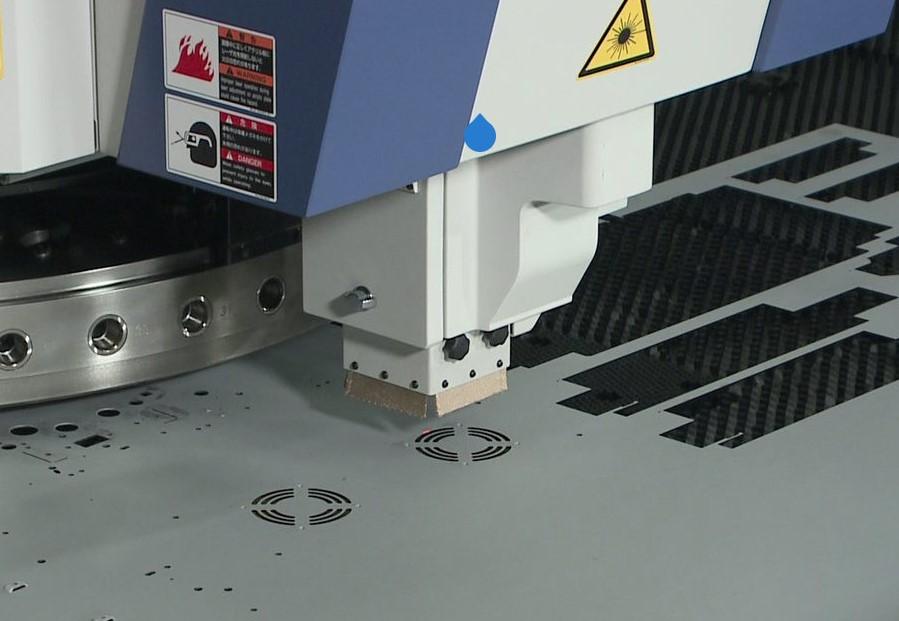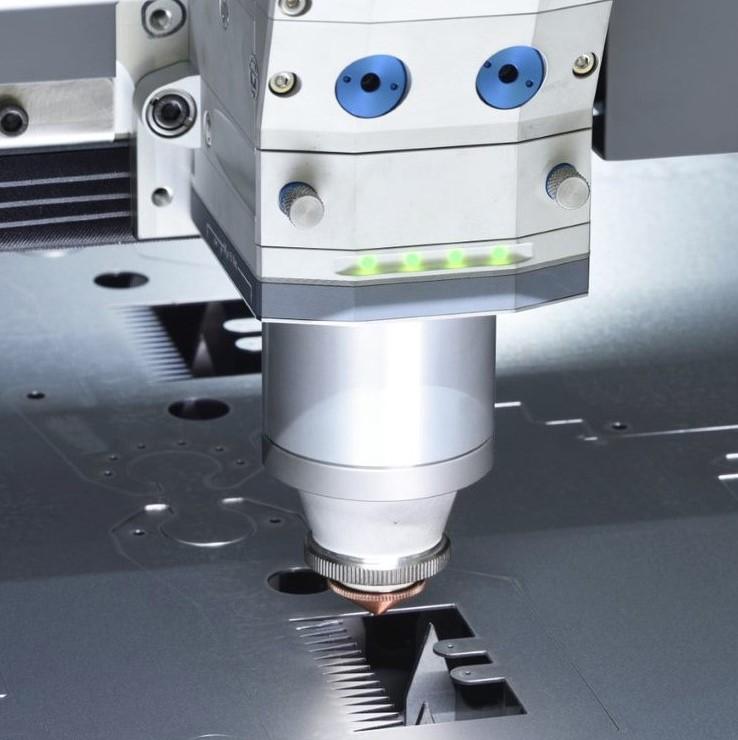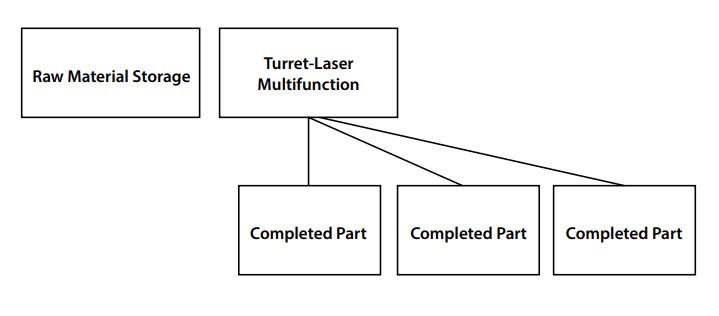North American Sales Manager
- FMA
- The Fabricator
- FABTECH
- Canadian Metalworking
Categories
- Additive Manufacturing
- Aluminum Welding
- Arc Welding
- Assembly and Joining
- Automation and Robotics
- Bending and Forming
- Consumables
- Cutting and Weld Prep
- Electric Vehicles
- En Español
- Finishing
- Hydroforming
- Laser Cutting
- Laser Welding
- Machining
- Manufacturing Software
- Materials Handling
- Metals/Materials
- Oxyfuel Cutting
- Plasma Cutting
- Power Tools
- Punching and Other Holemaking
- Roll Forming
- Safety
- Sawing
- Shearing
- Shop Management
- Testing and Measuring
- Tube and Pipe Fabrication
- Tube and Pipe Production
- Waterjet Cutting
Industry Directory
Webcasts
Podcasts
FAB 40
Advertise
Subscribe
Account Login
Search
Is a punch/laser machine right for your operation?
Metal fabrication shops might want to plan for a turret with a side of laser
- By Jeff Tyl
- July 28, 2021
- Article
- Punching and Other Holemaking

As with any technology, punch/laser machines have their advantages and disadvantages. Considering them all will help you determine if such a machine is a good fit.
Whether you work at a custom fabricator or OEM, your business grows and shrinks within the market it represents. Limited floor space is a common reason not to purchase new equipment. When floor space is available, you must decide the best piece of equipment to occupy it. To justify a new machine purchase, aside from determining the desired return on investment and profit margin, you must evaluate at a high level the machine requirements for processing, staging, and finishing.
When processes cross over multiple machines, punch/laser machines can in many cases maximize floor space, minimize work-in-process (WIP), eliminate the need for secondary processes, and increase overall production flexibility to fabricate a wide variety of parts. They can be a welcome addition to many fabricators with the right product mix.
First, however, let’s address some terminology. When machinery manufacturers talk about punch/laser combination machines, what exactly are they talking about? The word combination is defined as a joining or merging of different parts or qualities in which the elements are individually distinct and robust. In comparison, the word multifunction is defined as having or fulfilling several functions. So, considering what punch/lasers do and how they operate, are they combination machines or multifunction machines? Which name truly describes what the machine can do?
These machines have all the functionality of a turret punch press with the added value of a fiber laser. However, they comprise a turret base and a fiber laser addition, so are they combination machines? Remember the definition of combination—a joining or merging of different, individually distinct parts or qualities. If punch/lasers were true combination machines, they should have no limitations of either the turret or the laser—and this is not true.
The laser can cut only what the system can work-hold. In almost all cases, 0.25 in. is as thick as these machines can punch and laser-cut, which is why they come with 3- to 4-kW lasers. There is no need to put a high-powered laser on these machines because the laser is limited by the turret and the workholding of the sheet metal (see Figure 1).
In reality, punch/lasers are best described as a multifunction machine. Regardless of what you call them, though, these machines can help set many operations apart from the competition. That said, as with any technology investment, multifunction machines have their advantages and disadvantages. Considering all the pros and cons can help you make your available floor space as productive as it can be.
Multifunction Machine Advantages
Strong>Advantage 1: Eliminate WIP. WIP costs money. The longer parts sit on your shelf, pallet, or anywhere else as they wait to be processed at the next downstream station, the longer you are being the bank for someone else’s project.
Consider the process flow for a shop with a laser, a turret punch press, a press brake, and a tapping station (see Figure 2). You have nested correctly, your process has taken into consideration the flow of material to secondary operations, and at each value-added process you are increasing your margin. But what is the true cost of WIP?
Now consider Figure 3, which depicts the process flow for a multifunction punch/laser machine. The system eliminates three downstream operations and the WIP that comes with them. It now takes less time for raw material to reach the shipping dock as finished parts. Customers receive their parts faster, you recognize the revenue significantly sooner, and you increase your overall cash flow. Without a multifunction machine, WIP slowly makes its way through the process. You prolong the time between purchasing your raw material and invoicing for a shipped order.
Now consider the value stream in Figure 4. Producing parts on separate machines—laser, WIP, brake, WIP again, then tap—involves 21 minutes and 35 seconds of processing time. Moving the work to a turret-based multifunction machine shortens processing time by 76%, to 5 minutes and 11 seconds. So in this case, switching to a multifunction machine saves 16 minutes and 24 seconds of pure production time. Of course, the original material flow had WIP downtime that wasn’t counted in the total processing time.

FIGURE 1 The laser on a multifunction turret-punch-based machine can cut only what the machine's clamps can hold. For this reason, most multifunction machines come with lower-power lasers.
If time savings are so dramatic, why would anyone not change to a multifunction system? The answer, of course, is that not every application will achieve this amount of savings. Still, operations that involve the right mix of work can experience dramatic savings that can ultimately set them apart from the competition.
Multifunction machines can produce a varied mix of work, from the simple to the complex. They are not limited to parts requiring all the processes the machines can perform. They can be used as a standard turret punch press and, for sheet 0.25 in. and thinner, as a stand-alone laser with the ability to cut contoured edges.
Going a step further in maximizing work flow and handling, part sorting automation can reduce WIP, prevent incorrect part routing, and even minimize the chance of the dreaded lost or missing part. Shifting part routings from human pick-and-sort to machine pick-and-place can reduce errors, scrap, and overall production costs, all of which drive more profit to the bottom line. Similarly, automation in the form of production control software can help fabricators group similar materials, processes, and customers’ parts for scrap savings and streamlined flow, all while again reducing WIP.
Advantage 2: Retained and Retrained Workforce. Consider again the two previous scenarios. In one, parts are laser-cut, formed, and tapped on three separate machines, each of which has its own labor requirement:
- Laser cutting: Operator, programmer, material handler (shared)
- Forming: Separate operator
- Tapping: Separate operator
Now consider the labor requirements for one turret-based multifunction machine:
- Laser, form, tap: One operator, programmer, and material handler (shared)
The multifunction machine requires two fewer operators. Those two operators now can be retrained and learn new skills—such as welding, painting, or press brake operation—so they can move to free bottlenecks and improve work flow. The goal is to reduce the cost of manufacturing. By processing parts on a multifunction machine, you lower overhead and capture larger margins.
Advantage 3: Expanding Capabilities. For some fabricators, adding a multifunction machine means business is good. These operations dedicate the parts best suited for the machine. At the same time, they can continue running certain jobs on separate machines, including parts that do not require secondary or tertiary processes.
A multifunction machine can add significant capabilities. Say a fabricator with only a laser decides to add a multifunction machine. That operation now can integrate punching, forming, deburring, tapping, and laser all on one machine.
Consider another fabricator with only a turret that decides to invest in a multifunction system. That operation now has the added value of laser cutting for making large holes and curved part perimeters cost-effectively. This operation now can not only punch and form (as it did with the stand-alone turret), but also laser-cut and form in one machine, again reducing WIP and the associated downtime.
Multifunction Machine Disadvantages
Disadvantage 1: Price Tag. When taken at face value, the price of a multifunction machine could keep an operation from buying one. This could be a disadvantage for some fabricators with limited capex plans and cash flow.

FIGURE 2 This is a process flow for a shop with a laser, a turret punch press, a press brake, and a tapping station. Depending on the product mix and other factors, such an operation could benefit greatly from a multifunction machine.
>A stand-alone turret and laser can cost roughly the same (or sometimes less) than a multifunction machine. Buying separate machines gives fabricators all the functionality of punching and laser cutting, but they lose the operational benefits discussed previously.
Disadvantage 2: When Systems Go Down. Suppose a multifunction machine is your only system for producing sheet metal parts. What’s your plan when the system fails or is down for maintenance? Ideally, you purchased the preventive maintenance plan from the machine manufacturer and you have a backup plan.
Still, if your part mix relies on a multifunction machine for punching, forming, tapping, and laser cutting, you might need to find an outside processer with laser cutting and turret punching capabilities to support your fabrication needs. Alternatively, you might turn to a nearby competitor that has another multifunction machine with available capacity. This last alternative is far less likely than you might assume. Moreover, paying an outside processor with multiple machines and employees could cost you more than you budgeted on your own machine.
Disadvantage 3: Finding the Multifunction Sweet Spot. Finally, these machines tend to lend themselves to a sweet spot in manufacturing. What does this mean? Sweet spot is defined as an optimum point or combination of factors or qualities. How does this affect your business and, even more, the potential of selling these machines’ capabilities within the market?
Shops with multifunction machines must match a particular customer’s demand to what fits within the scope of the machine. Again, the machines are limited to material that’s 0.25 in. and thinner. If that fits 90% of your processing, a multifunction machine might be a perfect addition. However, if you process a range of materials that can’t be lumped into that 0.25-in.-and-thinner category, a multifunction system probably will give you only limited capabilities when running the material that you are accustomed to processing.
Multifunction machines with a fiber laser have enclosed cabinetry required by the FDA, which also limits the raw material size that the machine can handle. If you process oversized material wider than 60 in. or longer than 120 in., the turret-based multifunction machines can have issues with repositioning because of the constraints the enclosed production area creates.
The Value of Time
Are you just getting into sheet metal processing or considering bringing outsourced work in-house? Do you need to replace an older turret and CO2 laser? Do you have room? Do you need to get the most from limited floor space? Do the markets you serve demand products that could take advantage of what a multifunction machine can do? These questions can help you determine whether a multifunction machine is a good fit. You might not answer all of these questions, but if you at least consider all of them, you’ll have a much better idea whether a multifunction machine is the right fit for your operation.
Punch/laser combo machines—or newly named multifunction machines—are not for everyone, but they can be for anyone. Do not let this list of disadvantages discourage you from considering such a machine as an option. Keep in mind the distinct advantages that can outweigh the disadvantages.
Also, don’t overlook the hidden advantages. You can reduce the WIP-associated downtime. You can have fewer employees running fewer machines while working smarter, and you can expand your operational capabilities. All these advantages do not necessarily have an accompanying cost-of-goods-sold calculation, but they do indeed save time and money. Ask any business owner, what does a customer pay for when buying your product? The answer is time.
About the Author
Related Companies
subscribe now

The Fabricator is North America's leading magazine for the metal forming and fabricating industry. The magazine delivers the news, technical articles, and case histories that enable fabricators to do their jobs more efficiently. The Fabricator has served the industry since 1970.
start your free subscription- Stay connected from anywhere

Easily access valuable industry resources now with full access to the digital edition of The Fabricator.

Easily access valuable industry resources now with full access to the digital edition of The Welder.

Easily access valuable industry resources now with full access to the digital edition of The Tube and Pipe Journal.
- Podcasting
- Podcast:
- The Fabricator Podcast
- Published:
- 04/16/2024
- Running Time:
- 63:29
In this episode of The Fabricator Podcast, Caleb Chamberlain, co-founder and CEO of OSH Cut, discusses his company’s...
- Industry Events
16th Annual Safety Conference
- April 30 - May 1, 2024
- Elgin,
Pipe and Tube Conference
- May 21 - 22, 2024
- Omaha, NE
World-Class Roll Forming Workshop
- June 5 - 6, 2024
- Louisville, KY
Advanced Laser Application Workshop
- June 25 - 27, 2024
- Novi, MI
































